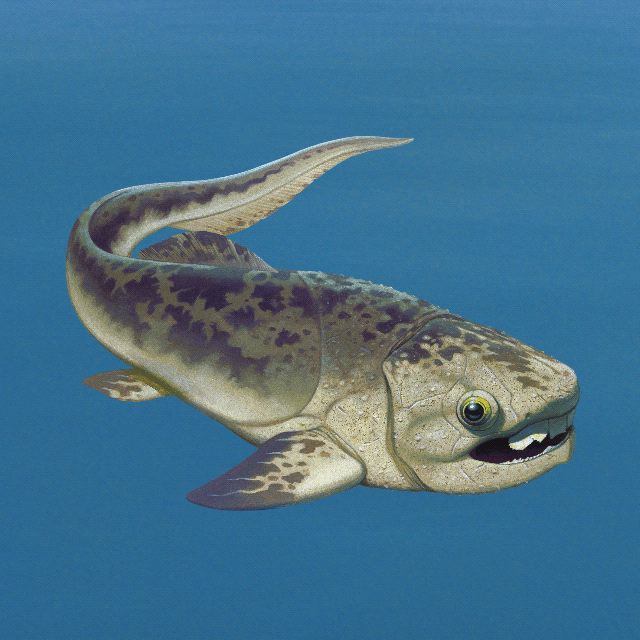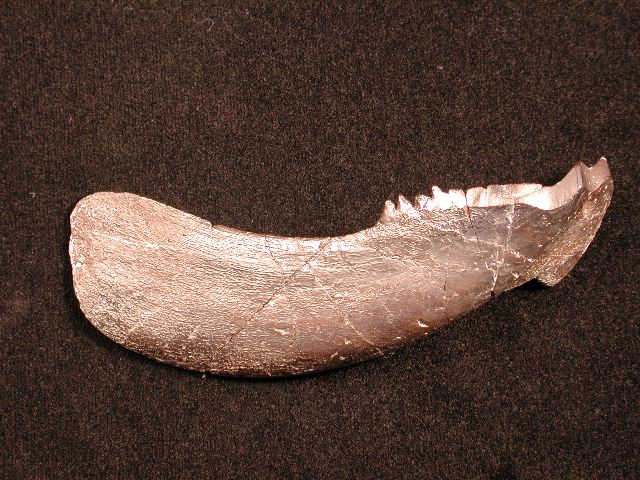Plourdosteus

 (52 kb) Although dwarfed in comparison to its American cousin, the giant Dunkleosteus of Ohio, Plourdosteus canadensis nonetheless ruled the Miguasha paleoestuary where its size was on par with other large fish. Its svelte body and the solid carapace covering its head and trunk made for a swift predator and a tough prey for any fish that attacked it from the front.
(52 kb) Although dwarfed in comparison to its American cousin, the giant Dunkleosteus of Ohio, Plourdosteus canadensis nonetheless ruled the Miguasha paleoestuary where its size was on par with other large fish. Its svelte body and the solid carapace covering its head and trunk made for a swift predator and a tough prey for any fish that attacked it from the front.Its jaws consisted of two lower mandibles with a partly mobile symphysis (central junction). The jaws closed behind four smaller upper plates along the front of the skull. In juveniles, small distinct teeth are seen on each of these structures, but wear over the life of the animal caused the jaws to become one continuous cutting edge.

 (20 kb)Despite the absence of three-dimensional specimens, wear marks left on the jaw structures enabled paleontologists to understand how this fish chewed its food. Results show that the movements were mainly abduction and adduction, simple opening and closing, and did not seem to involve propulsion or retropulsion, forward and backward movements.
(20 kb)Despite the absence of three-dimensional specimens, wear marks left on the jaw structures enabled paleontologists to understand how this fish chewed its food. Results show that the movements were mainly abduction and adduction, simple opening and closing, and did not seem to involve propulsion or retropulsion, forward and backward movements. Arthrodires normally have an internal cartilaginous skeleton, but that of Plourdosteus reveals a partially ossified spinal column, which must have helped it swim more efficiently.

 (100 kb)Baptized Coccosteus canadensis when it was first discovered, due to its resemblance to a species in the Old Red Sandstone of Scotland, differences in the skull bone pattern caused it to be renamed Plourdosteus in 1951. Its name renders homage to the Plourde family at Miguasha, who were well known among paleontologists visiting the area. From one generation to the next, the Plourde family came to know more and more about the Escuminac Formation and its fossils, helping to enrich the collections of many paleontological institutions in Quebec and around the world.
(100 kb)Baptized Coccosteus canadensis when it was first discovered, due to its resemblance to a species in the Old Red Sandstone of Scotland, differences in the skull bone pattern caused it to be renamed Plourdosteus in 1951. Its name renders homage to the Plourde family at Miguasha, who were well known among paleontologists visiting the area. From one generation to the next, the Plourde family came to know more and more about the Escuminac Formation and its fossils, helping to enrich the collections of many paleontological institutions in Quebec and around the world.Site map | Feedback | Links | Sources | Credits
Plourdosteus
<< Arthrodires | Acanthodians >>

Title: Reconstruction of Plourdosteus canadensis
Author: Illustration by François Miville-Deschênes
Sources: Parc national de Miguasha
Year: 2003
Description:
The placoderm Plourdosteus canadensis was a predator in the Devonian ecosystem at Miguasha. The name Plourdosteus commemorates the important role that the Plourde family played in the history of the Miguasha site. Members of the Plourde family were active for more than a century, taking part in many fossil digs.

Title: Plourdosteus canadensis
Author: Illustration by Philippe Janvier
Sources: Parc national de Miguasha
Year: 2003
Description:
This jaw plate from Plourdosteus canadensis was removed from the encasing rock using acid.

Title: Lower jaw plate from Plourdosteus
Author: Parc national de Miguasha
Sources: Parc national de Miguasha
Year: 2002
Description:
The bony plates that made up the jaw of Plourdosteus were worn down to a continuous cutting edge through constant use during the life of the animal. The lower jaw plate shown here still bears several small sharp teeth, indicating that the fish was still young when it died. Daniel Vézina prepared the specimen using acid.


